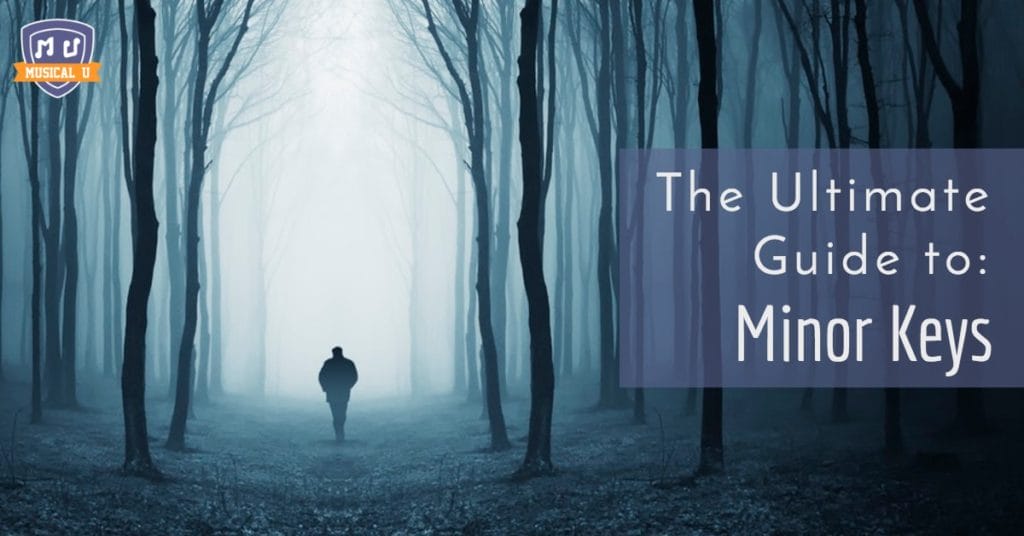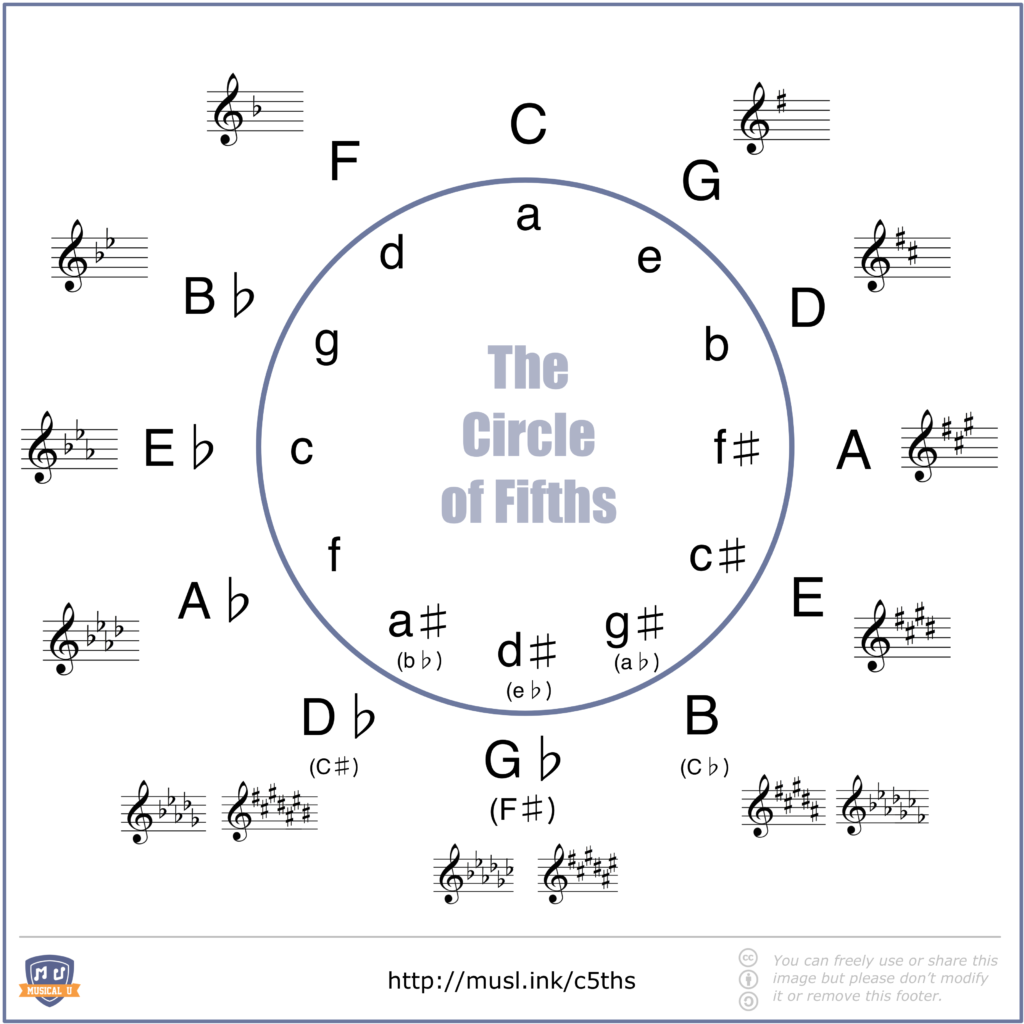While major scales have their place in the joyful, the bright, and the hopeful, minor keys are the mastermind behind the music that tears at your heartstrings.
Best of all, minor keys do not limit you to songs that are exclusively sad and wistful; you can just as easily evoke feelings of mystery, dread, tension, and even hope and optimism. Believe it or not, countless pop songs are written in minor keys!
For example, Santana’s “Oye Como Va” is written in A minor, but many wouldn’t ever guess that from its jubilant groove:
Several questions arise: why do minor keys usually sound sad? What is the difference between major vs. minor keys? How do you play in a selected minor key?
In this comprehensive guide to minor keys, we’ll cover all of this and more. Read on to learn the theory behind minor keys, how to build minor scales, chords, and intervals, and how to listen for them in the songs you know and love.
Table of Contents
3. Minor Keys and the Circle of Fifths
4. Minor Scales
5. Building Chords in Minor Keys
What is a Minor Key?
First off, let’s understand minor keys by applying some basic music theory.
A musical key is, by definition, a certain collection of notes that a piece of music is composed in. There are a total of 12 minor keys, and each minor key contains seven notes that can be used to write music in that key.
So, what makes a minor key a minor key? It’s the pitch difference between the notes in the key. If arranged in ascending order, the seven notes within a key form a scale, which when played, makes that unmistakable wistful and sad sound.
Listen to the C major and C minor natural scales, and you can immediately recognize the upbeat, bright character of the major scale, and the melancholy mood of the minor scale:


Tones and Semitones
Looking at the scores, it is evident that the two scales use different notes. Looking closer still, you can see that the spaces between the notes differ also.
The semitone is the smallest interval in Western music, and is the interval between two adjacent notes (for example, C and C♯). A whole tone, or simply a tone, is comprised of two semitones, with an example being C and D. Semitones and tones are also known as half steps and whole steps, respectively. For the purposes of this article, we will be using the semitone (ST) and tone (T) terminology. Modern Songstress has a more in-depth description of whole tones and semitones, for those interested.
Let’s look at how semitones and tones are used to build up the major and minor scale:


Comparing the patterns:
- T-T-ST-T-T-T-ST (major)
- T-ST-T-T-ST-T-T (minor)
This difference in the sequence of steps results in each scale having a completely different sound.
As we will look at later, the most important difference between major and minor is the third note in the scale.
From One Scale to Three:
As we will see, there are not one, but three 7-note minor scales, each with their own rich, distinctive sound. However, one thing they share in common is the same tone-semitone pattern between the first five notes: T-ST-T-T.
In fact, all natural minor scales share this tone-semitone pattern. That’s right: whether the minor key is the accidental-free A minor or the A♯ minor scale that features seven sharps, the tone-semitone pattern never deviates in the natural minor scale.
With this knowledge, we can build a natural minor scale starting on any note. However, if you already know your major scales, there’s an easy way to figure out minor scales without counting tones and semitones.
Finding Minor from Major
Though they may sound worlds apart, major and minor keys are in fact closely related. You can easily convert major keys to minor keys simply by understanding the concept of relative keys.
Each major key has a relative minor, with which it shares a key signature.
The relative minor is found on the sixth scale degree of a major key, or three semitones down from its corresponding major key. For example, the relative minor of C major is A minor.
Try it out: what is the relative minor of F♯ major?
Show answer
For a bit more on this, head over to Essential Music Theory for another useful explanation of relative minors, including a great keyboard visualization of the concept.
Relative keys have a special relationship: not only do they share a key signature, but they contain all the same notes. Therefore, if you can name the notes of a major scale, you already know the pitches of its relative minor.
There exists another kind of relationship between major and minor keys: the parallel minor of a major key starts on the same note, but contains different notes. No Treble helpfully compares and contrasts the two concepts of relative minor and parallel minor.
Minor Keys and the Circle of Fifths
There’s an even easier way of understanding major-minor relationships, the notes contained within keys, and key signatures.
If you need to find all the notes within a certain minor key, you don’t need to count semitones and tones to find the notes or the relative minor – you can instead look directly to the Circle of Fifths to find which notes will be flatted or sharped:
Finding the Notes Using the Circle
To understand minor key signatures and how they can help us find the notes contained in a minor key, remember: a relative minor is found three semitones down from its corresponding major key, with which it shares a key signature. On our handy circle of fifths, the outer circle contains the major keys, the inner circle shows their relative minors, and the key signatures of each are major-minor pairing are shown adjacent. If you really want to dig into the mechanics of the circle, Pianote gives an excellent explanation of the construction and works of the circle.
Let’s say you need to figure out the pitches found in C♯ minor. Looking at the circle, C♯ minor has four accidentals: F♯, C♯, G♯, and D♯. This means that starting with the tonic, your pitches for this key will be C♯, D♯, E, F♯, G♯, A, and B.
Try it yourself: what would the notes of the key of F minor be?
Show answer
Minor Key Signatures
To get used to finding key signatures on the Circle, try the exercise below. You’ll be given a specific key signature – look to the circle to find the minor key it belongs to.
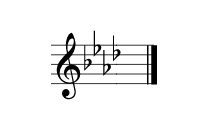
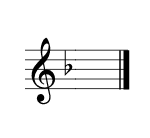
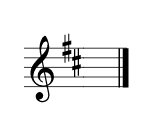
Show answer
- F minor
- D minor
- B minor
It’s worth noting that you may not have the circle handy at all times. In these cases, there is a simple trick you can use to quickly determine the key signature from the key and vice versa, as detailed by A Higher Note.
Minor Scales
Minor scales offer rich harmonic and melodic variety that’s not found in major. In fact, there are a variety of minor scales available for your musical expression. Here, we’ll look at the three most ubiquitous and useful minor scales.
Bear in mind that there is actually another world of minor scales outside these three – the minor pentatonic is another useful scale, especially for soloing, as explained by Guitar Habits.
The Natural Minor Scale
Look closely at the pitches you derived from the circle of fifths – when placed in ascending order, they form a scale. The natural minor scale, to be exact. To verify this, you can count the whole tones and half tones and check if they fit the signature T-ST-T-T-ST-T-T pattern.

How To Sing Smarter has created a great vocal exercise to get you singing in A natural minor. This will help you recognize the distinctive feel of the natural minor scale, as well as developing your sight-singing skills.
Moving beyond the natural minor, something interesting starts to happen when we add accidentals…
The Harmonic Minor Scale
If you make a little tweak to the natural minor by raising the seventh degree of the scale, you obtain the harmonic minor scale:

This raised seventh degree makes quite a difference in sound. It adds a hint of tension to the scale, which then resolves once the tonic is reached. The harmonic minor scale is a useful tool for jazz guitarists, and as Jazz Guitar Online explains, it can be used to solo over chord progressions in a fascinating way.
Once you get comfortable with the notes of harmonic minor scales, a world of improvisation opens up to you. Kent Hewitt shows how you can begin improvising in the fifth mode of a harmonic scale, which simply means using the fifth note of the harmonic scale as your tonic:
The Melodic Minor Scale
If you raise both the sixth and the seventh degrees of the natural minor scale, you’re left with the melodic minor scale:

The notes in the A melodic minor scale are A, B, C, D, E, F♯, and G♯.
But wait! The melodic minor has more tricks up its sleeve. On the way down, the sixth and seventh degrees are lowered back down to their natural minor places:

What?! A scale that goes up one way and down the other? How could that be?
The melodic minor actually came about by reflecting how Baroque composers of the 1600s and 1700s solved the problems of minor harmonies (more on that later). The best part is that minor melodies in this scale offer two extra note choices than the standard seven-note scales.
The principle seems strange, but when you hear it all together, the melodic minor sounds quite musical:
The melodic minor is an interesting scale sonically. In the first half of the ascending scale, A-B-C-D-E follows the pattern of tone-semitone-tone-tone, the same as the natural minor. Meanwhile, the second half, E-F♯-G♯-A, is a tone-tone-semitone pattern, which is the beginning of a major scale pattern. Therefore, the scale starts off sounding minor, and then switches to sounding major. This lends an interesting, conflicting quality to the scale and places it somewhere between major and minor. It also gives it internal dissonance in the form of tritones, which is the name for an interval formed by three whole tones:

The tension and musical interest that the tritones and major/minor ambiguity add to the melodic minor scale make it perfect for jazz and experimental music, though it is found in classical and popular music as well. An example is the famous “Carol of the Bells”:
If you’re a little unclear on how each of these minor scales is formed, check out MusicTheory.net’s step-by-step construction of the natural, harmonic, and melodic scales! Then, try forming each type of minor scale in different keys to cement your understanding. EarMaster provides an excellent exercise for building these scales in various keys.
Building Chords in Minor Keys
Because there is not one, but three different types of minor scales at your disposal, the opportunities for chord-building are bigger than with the major scale.
To build a chord on any note in a specific minor key, simply add a third and a fifth above the note, applying the key’s accidentals where appropriate.
Let’s take a look at the chords available to you from the natural, harmonic, and melodic minors. We will use Roman numeral notation to represent the chords built on each minor key scale degree – however, the Nashville number system, which uses regular numerals to denote scale degrees, may also be used.
Here are the chords built on the A natural minor scale. You’ll notice no accidentals, and that the resultant chords take on different qualities based on the distances between the notes:

Here are the chords built on the A harmonic minor scale. G♯ is present instead of G, because of the raised seventh degree in harmonic scales:

Lastly, here are the chords built on the A melodic minor scale. The sixth and seventh degrees are raised in the ascending scale, but not in the descending scale:
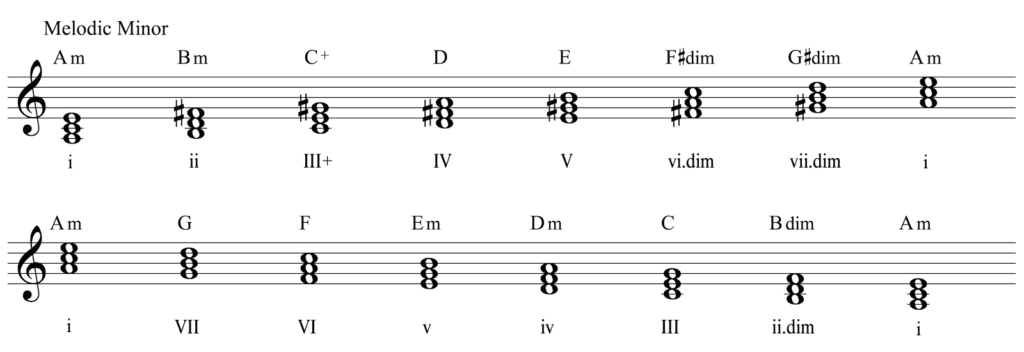
When we write chord progressions in minor keys, we can use the chords directly from these scales. Depending on which minor scale we use, we can get different progressions:
- If we use the natural minor scale, we will obtain a progression of i-iv-v (all minor chords)
- With the harmonic minor, the progression is i-iv-V
- With the melodic minor, the progression is i-IV-V
This is a big part of what makes minor keys so rich and nuanced.
Listening for Minor Keys
As you can see, the accidentals of minor keys will lead to the formation of chords that are either major, minor, augmented, or diminished. Let’s focus on those first two.
The Importance of the Minor Third
In many cases, what separates a major chord from a minor chord is the middle note – that is, the third. A major third will have a bright sound:
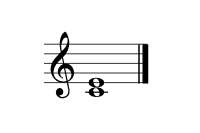
While a minor third will sound far more serious:
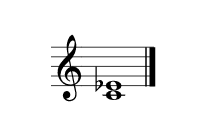
The minor third is incredibly important in Western music. Not only does it help form the backbone of minor chords, but it sounds great as a standalone interval. In fact, it’s the darling of the jazz improvisation world, as detailed by Altobone.
There is a myriad of ways you can train your ear to distinguish major from minor, and even different types of minor scales and chords from one another. It is likely that your ear can already pick out minor key melodies from their wistful sound.
Major vs. Minor Chords
Let’s start with a straightforward comparison:
Listen to each – the difference should jump out at you. The major chord sounds bright and happy, while the minor chord sounds dark, gloomy and sad.
Chances are, your ear is quite good at telling apart major and minor. See if you can determine the tonality of the following chords! Answers are below.
Show answers
- Example 1: C Major
- Example 2: F Major
- Example 3: G Minor
- Example 4: E Minor
- Example 5: B Minor
- Example 6: E Major
You can extend this logic to a full song. If the tune sounds bright or happy, uses mostly major chords and generally comes to rest on a major chord, it’s probably a major key. If the song sounds dark and gloomy, uses mostly minor chords and generally comes to rest on a minor chord, it’s probably a minor key.
Predictably, transforming a major key song into a minor key song will result in a dramatic shift in the song’s mood. For example, listen to what happens to the Village People’s “YMCA” when it is transposed into a minor key:
The mood shifts considerably! Minor key versions of major songs sound darker, more tense, and more epic.
Listening for the Tonic
The tonic is truly the anchoring point of a song. As such, songs often tend to begin and/or end on the tonic or on the chord built on the tonic.
In a song written in a minor key, the melody or chord progression will often conclude on the minor chord built on the tonic of that minor key.
For example, if we have a i-iv-v-i chord progression, it naturally resolves back to the tonic i chord:

Listening for Minor Chord Progressions
Minor key chord progressions exist in many flavours, thanks to the presence of the natural, harmonic, and melodic minor scales. With some practice, you can train your ear to determine which scale the chord progression you’re hearing is based on.
Let’s have another look at the above progression:

This i-iv-v-i progression is based on the natural minor scale, as evidenced by the lack of raised sixth and seventh degrees.
Let’s tweak this sequence slightly to form a progression based on the harmonic minor scale, by replacing the minor v chord with a major V chord. This is achieved by raising the seventh degree of the scale, which corresponds to the middle note in the chord built on the fifth degree of the scale. In A minor, this raises the G to a G♯:

Listen for the difference between the i-iv-v-i and the i-iv-V-i progressions. What quality does that raised seventh lend to the latter progression?
This type of chord progression is where the harmonic minor scale becomes a handy soloing tool. As explained by Zombie Guitar, the A natural minor scale will sound great when soloing over those Am and Dm chords, but will not work with the E major (V) chord. However, the A harmonic minor will work beautifully over that major V chord.
As for the melodic minor scale, it is less commonly used as a basis for chord progressions. Composers tend to instead use it for melodies, as its name implies.
If we were to tweak our original i-iv-v-i progression to fit the notes of the A melodic minor scale, the resultant progression is i-IV-V-i:

The raised sixth degree results in a major chord built on the fourth degree of the scale, with the notes D, F♯, and A. As before, the raised seventh degree results in a major chord on the fifth degree of the scale, with the notes E, G♯, and B.
The World of Minor
As you delve deeper into the rich world of minor keys, melodies, and chord progressions, you’ll realize how much musical interest and depth they can add. The worlds of major and minor are certainly not separate – they often coexist beautifully, with a song containing both major and minor chords (and chord progressions!) that complement one another.
Equipped with everything you’ve learned in this Ultimate Guide to Minor Keys, listen and deepen your enjoyment of your favourite minor key songs, as you pick out the tonic minor chord, the scales that the riffs, licks, and solos are built on, and (after enough practice) the minor chord progressions you’re hearing.

